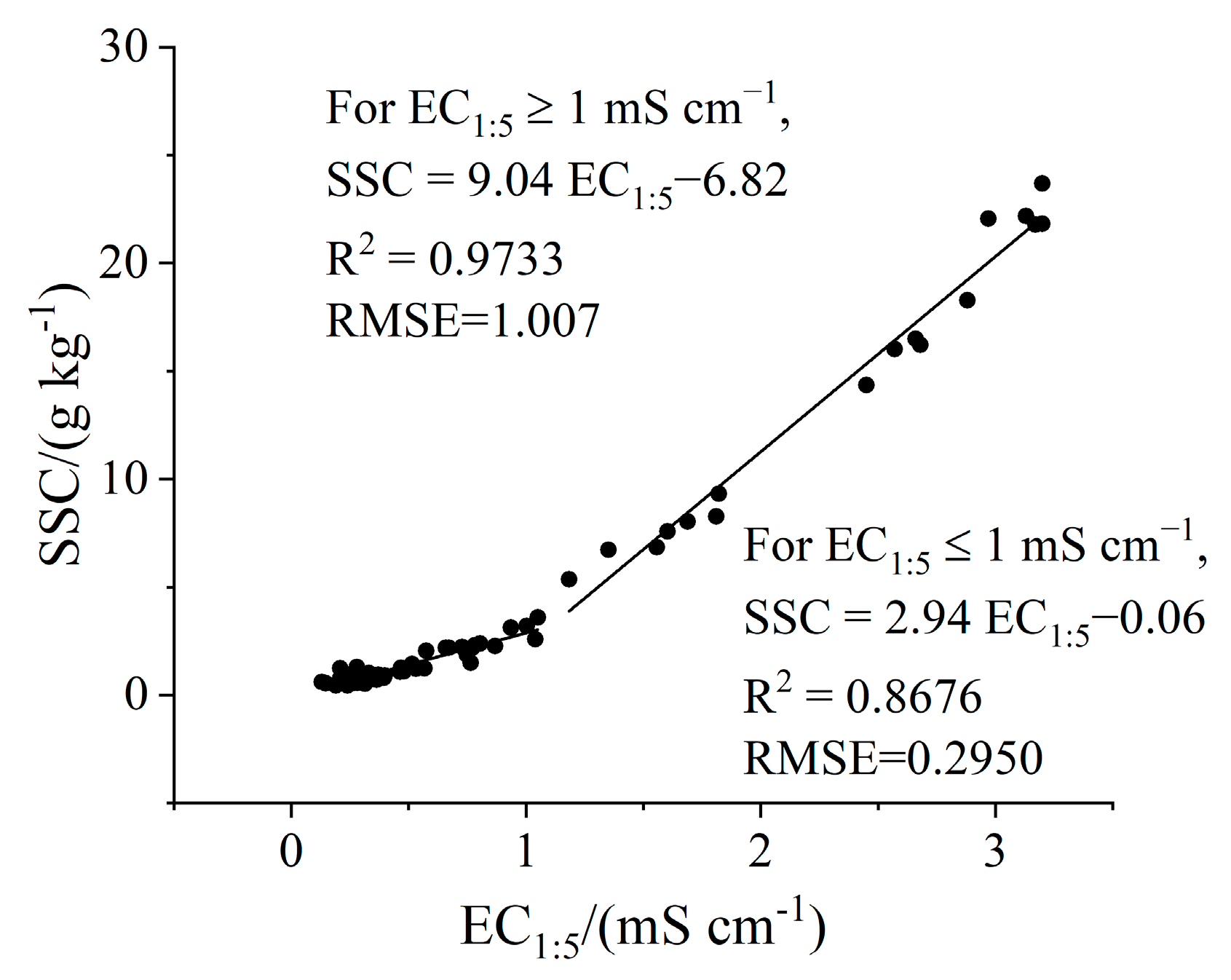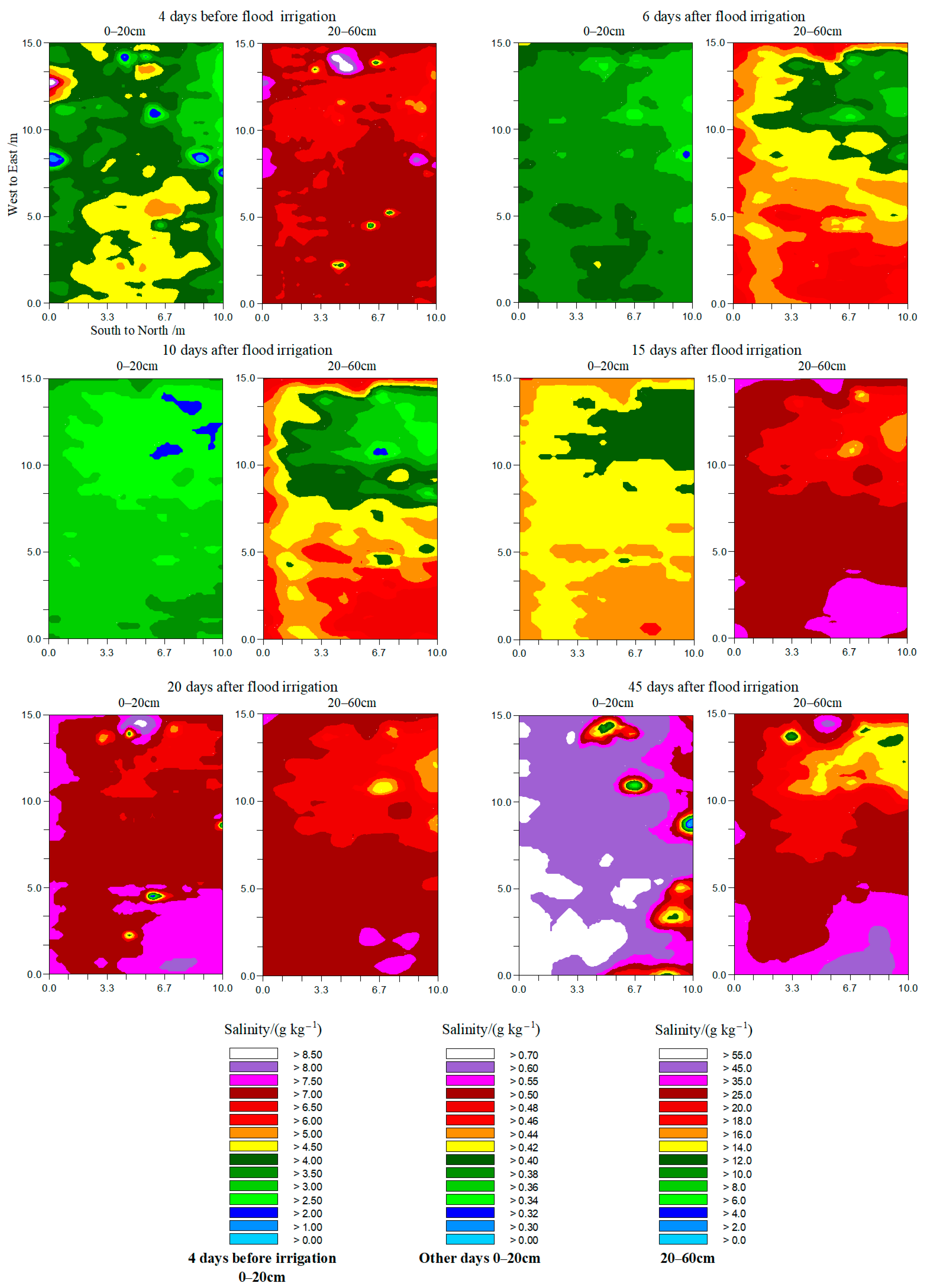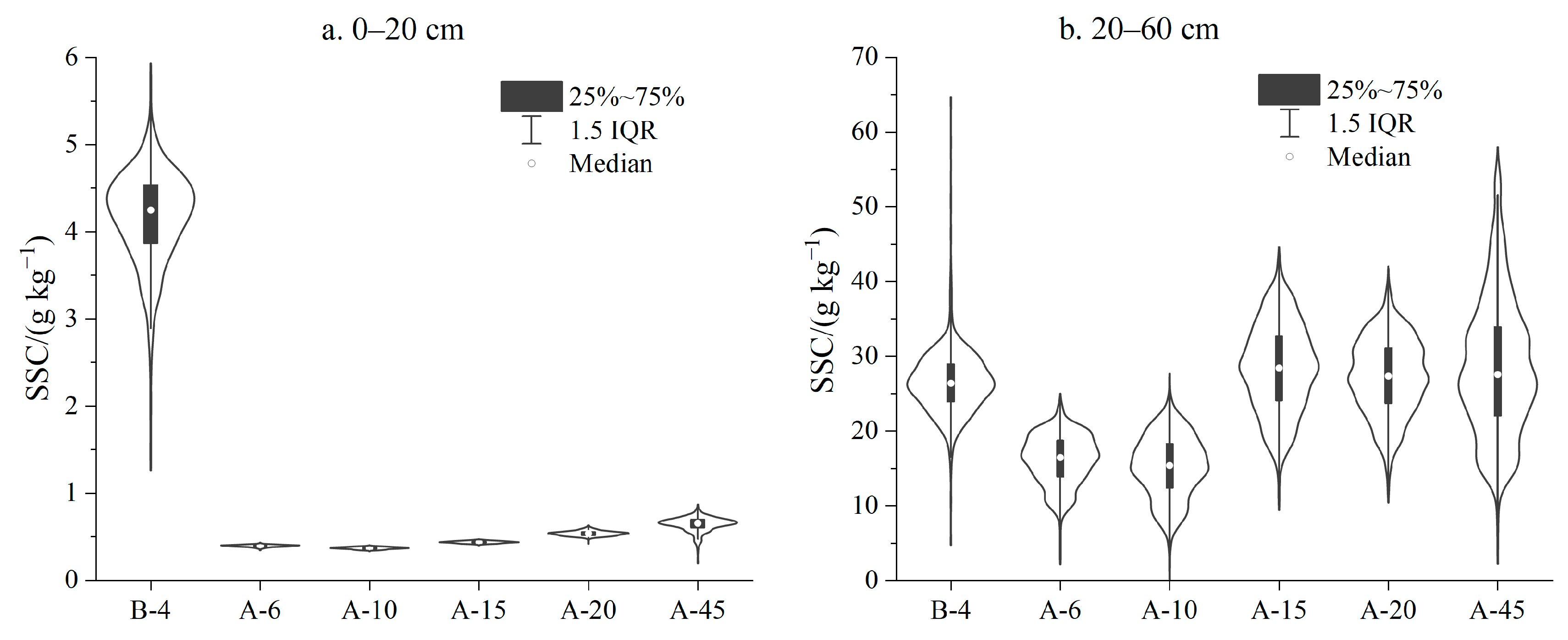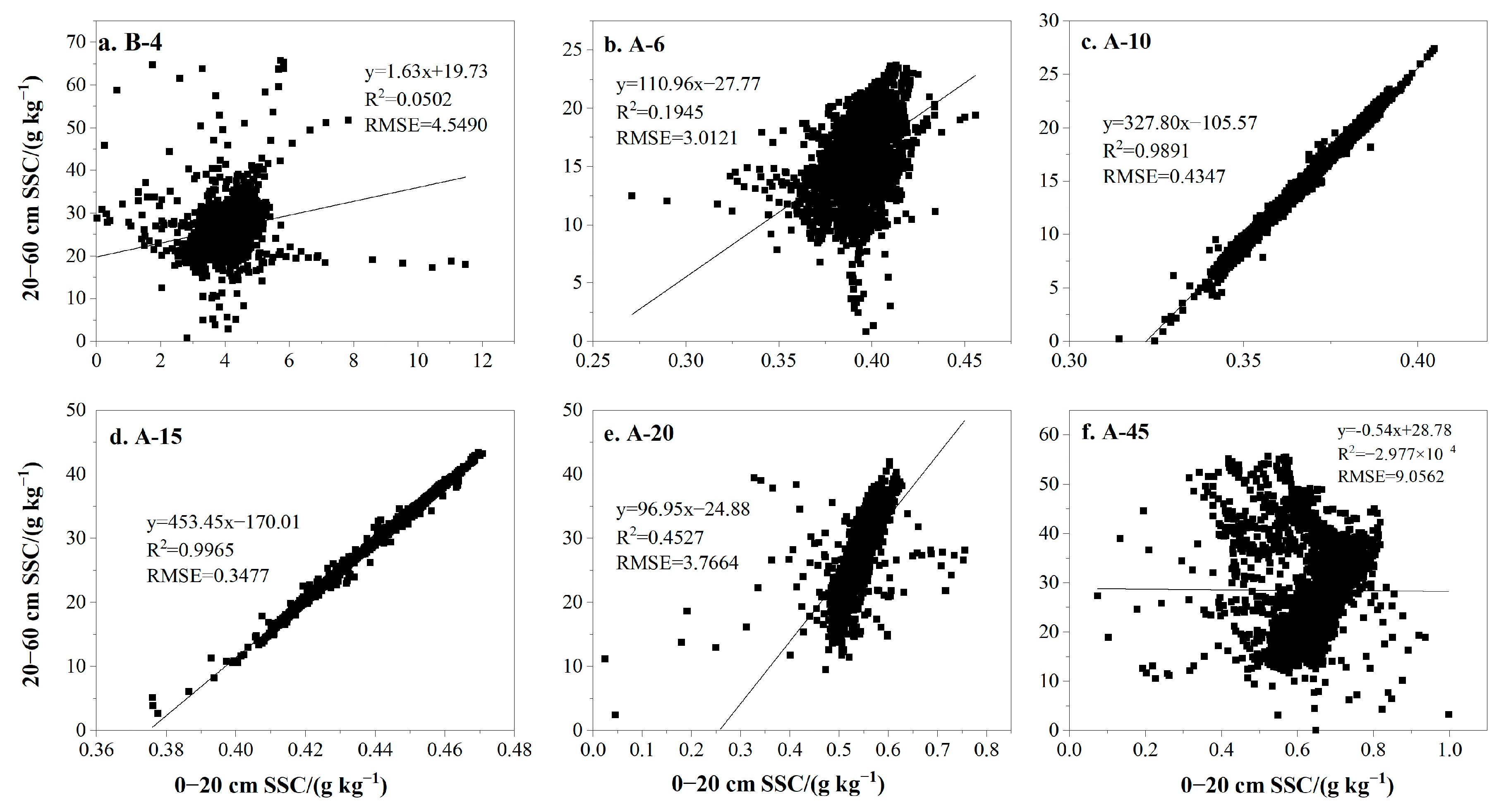Temporal and Spatial Assessment of Soil Salinity Post-Flood Irrigation: A Guide to Optimal Cotton Sowing Timing
Abstract
:1. Introduction
2. Materials and Methods
2.1. Study Site
2.2. Experimental Design
2.3. Electromagnetic Induction Survey
2.4. Geostatistical Analysis
2.5. Soil Salinity Classification
3. Results
3.1. Regressions between Soil Electrical Conductivity and Soil Salinity
3.2. Optimal Semi-Variance Function Models of Soil Salinity
3.3. Spatial and Temporal Variations of Soil Salinity
3.4. Classification of Soil Salinity
4. Discussion
4.1. Salinity Inversion Model Needs Real-Time Calibration
4.2. Flood Irrigation Redistributed Soil Salinity across the Field
4.3. Salinity Correlation between Surface and Deeper Layer Changed over Time
4.4. Recommendation for Optimal Sowing Timing
5. Conclusions
Author Contributions
Funding
Data Availability Statement
Conflicts of Interest
References
- Singh, A. Soil salinization management for sustainable development: A review. J. Environ. Manag. 2021, 277, 111383. [Google Scholar] [CrossRef]
- Liu, B.; Wang, S.; Kong, X.; Liu, X.; Sun, H. Modeling and assessing feasibility of long-term brackish water irriga-tion in vertically homogeneous and heterogeneous cultivated lowland in the North China Plain. Agric. Water Manag. 2019, 211, 98–110. [Google Scholar] [CrossRef]
- Chen, W.; Jin, M.; Ferré, T.P.A.; Liu, Y.; Xian, Y.; Shan, T.; Ping, X. Spatial distribution of soil moisture, soil salinity, and root density beneath a cotton field under mulched drip irrigation with brackish and fresh water. Field Crop. Res. 2018, 215, 207–221. [Google Scholar] [CrossRef]
- Li, X.; Jin, M.; Zhou, N.; Jiang, S.; Hu, Y. Inter-dripper variation of soil water and salt in a mulched drip irrigated cotton field: Advantages of 3-D modelling. Soil Tillage Res. 2018, 184, 186–194. [Google Scholar] [CrossRef]
- Wang, Z.; Jin, M.; Šimůnek, J.; Genuchten, M.T.V. Evaluation of mulched drip irrigation for cotton in arid Northwest China. Irrig. Sci. 2014, 32, 15–27. [Google Scholar] [CrossRef]
- Selim, T.; Bouksila, F.; Berndtsson, R.; Persson, M. Soil Water and Salinity Distribution under Different Treatments of Drip Irrigation. Soil Sci. Soc. Am. J. 2013, 77, 1144–1156. [Google Scholar] [CrossRef]
- Ortiz, A.C.; Jin, L. Chemical and hydrological controls on salt accumulation in irrigated soils of southwestern U.S. Geoderma 2021, 391, 114976. [Google Scholar] [CrossRef]
- Shokri-Kuehni, S.M.S.; Raaijmakers, B.; Kurz, T.; Or, D.; Helmig, R.; Shokri, N. Water table depth and soil salinization: From pore-scale processes to field-scale responses. Water Resour. Res. 2020, 56, e2019WR026707. [Google Scholar]
- Liu, Q.; Mou, X.; Cui, B.; Ping, F. Regulation of drainage canals on the groundwater level in a typical coastal wet-lands. J. Hydrol. 2017, 555, 463–478. [Google Scholar] [CrossRef]
- Che, Z.; Wang, J.; Li, J. Determination of threshold soil salinity with consideration of salinity stress alleviation by applying nitrogen in the arid region. Irrig Sci. 2022, 40, 283–296. [Google Scholar] [CrossRef]
- Zheng, Z.; Zhang, F.; Ma, F.; Chai, X.; Zhu, Z.; Shi, J.; Zhang, S. Spatiotemporal changes in soil salinity in a drip-irrigated field. Geoderma 2009, 149, 243–248. [Google Scholar] [CrossRef]
- Ren, D.; Wei, B.; Xu, X.; Engel, B.; Li, G.; Huang, Q.; Xiong, Y.; Huang, G. Analyzing spatiotemporal characteristics of soil salinity in arid irrigated agro-ecosystems using integrated approaches. Geoderma 2019, 356, 113935. [Google Scholar] [CrossRef]
- Akramkhanov, A.; Martius, C.; Park, S.J.; Hendrickx, J.M.H. Environmental factors of spatial distribution of soil salinity on flat irrigated terrain. Geoderma 2011, 163, 55–62. [Google Scholar] [CrossRef]
- Mukhamediev, R.; Amirgaliyev, Y.; Kuchin, Y.; Aubakirov, M.; Terekhov, A.; Merembayev, T.; Yelis, M.; Zaitseva, E.; Levashenko, V.; Popova, Y.; et al. Operational Mapping of Salinization Areas in Agricultural Fields Using Machine Learning Models Based on Low-Altitude Multispectral Images. Drones 2023, 7, 357. [Google Scholar] [CrossRef]
- Chen, Y.; Du, Y.; Yin, H.; Wang, H.; Chen, H.; Li, X.; Zhang, Z.; Chen, J. Radar remote sensing-based inversion model of soil salt content at different depths under vegetation. PeerJ 2022, 10, e13306. [Google Scholar] [CrossRef]
- Du, R.; Chen, J.; Zhang, Z.; Chen, Y.; He, Y.; Yin, H. Simultaneous estimation of surface soil moisture and salinity during irrigation with the moisture-salinity-dependent spectral response model. Agric. Water Manag. 2022, 265, 107538. [Google Scholar]
- Gerardo, R.; de Lima, I.P. Sentinel-2 Satellite Imagery-Based Assessment of Soil Salinity in Irrigated Rice Fields in Portugal. Agriculture 2022, 12, 1490. [Google Scholar] [CrossRef]
- Gu, S.; Jiang, S.; Li, X.; Zheng, N.; Xia, X. Soil salinity simulation based on electromagnetic induction and deep learning. Soil Tillage Res. 2023, 230, 105706. [Google Scholar] [CrossRef]
- Semiz, G.D.; Suarez, D.L.; Lesch, S.M. Electromagnetic sensing and infiltration measurements to evaluate turfgrass salinity and reclamation. Sci. Rep. 2022, 12, 5115. [Google Scholar] [CrossRef]
- Khongnawang, T.; Zare, E.; Srihabun, P.; Triantafilis, J. Comparing electromagnetic induction instruments to map soil salinity in two-dimensional cross-sections along the Kham-rean Canal using EM inversion software. Geoderma 2020, 377, 114611. [Google Scholar] [CrossRef]
- Yao, R.; Yang, J. Quantitative evaluation of soil salinity and its spatial distribution using electromagnetic induc-tion method. Agric. Water Manag. 2010, 97, 1961–1970. [Google Scholar] [CrossRef]
- Akça, E.; Aydin, M.; Kapur, S.; Kume, T.; Nagano, T.; Watanabe, T.; Çilek, A.; Zorlu, K. Long-term monitoring of soil salinity in a semi-arid environment of Turkey. Catena 2020, 193, 104614. [Google Scholar] [CrossRef]
- Li, X.; Jin, M.; Huang, J.; Yuan, J. The soil–water flow system beneath a cotton field in arid north-west China, ser-viced by mulched drip irrigation using brackish water. Hydrogeol. J. 2015, 23, 35–46. [Google Scholar] [CrossRef]
- Li, X.; Jin, M.; Zhou, N.; Huang, J.; Jiang, S.; Telesphore, H. Evaluation of evapotranspiration and deep percolation under mulched drip irrigation in an oasis of Tarim basin, China. J. Hydrol. 2016, 538, 677–688. [Google Scholar] [CrossRef]
- Liu, H.; Wu, B.; Zhang, J.; Bai, Y.; Li, X.; Zhang, B. Influence of Interlayer Soil on the Water Infiltration Characteristics of Heavy Saline–Alkali Soil in Southern Xinjiang. Agronomy 2023, 13, 1912. [Google Scholar] [CrossRef]
- Sila, A.; Pokhariyal, G.; Shepherd, K. Evaluating regression-kriging for mid-infrared spectroscopy prediction of soil properties in western Kenya. Geoderma Reg. 2017, 10, 39–47. [Google Scholar] [CrossRef]
- Zhang, G.; Liu, F.; Song, X. Recent progress and future prospect of digital soil mapping: A review. J. Integr. Agr. 2017, 16, 2871–2885. [Google Scholar]
- Shaqour, F.; Taany, R.; Rimawi, O.; Saffarini, G. Quantifying specific capacity and salinity variability in Amman Zarqa Basin, Central Jordan, using empirical statistical and geostatistical techniques. Environ. Monit. Assess. 2016, 188, 46. [Google Scholar] [CrossRef]
- Yang, Z. Tutorial on Geo-Data Analysis; Science Press: Beijing, China, 2008. (In Chinese) [Google Scholar]
- Jiang, G. Spatial Variability of Soil Salinity across Different Scale and Its Uncertainty Analysis. Master’s Thesis, China University of Geoscience, Wuhan, China, 2012. (In Chinses). [Google Scholar]
- Guo, Y.; Zhou, Y.; Zhou, L.; Liu, T.; Wang, L.; Cheng, Y.; He, J.; Zheng, G. Using proximal sensor data for soil salin-ity management and mapping. J. Integr. Agr. 2019, 18, 340–349. [Google Scholar] [CrossRef]
- Usowicz, B.; Lipiec, J.; Lukowski, M. Evaluation of soil moisture variability in poland from SMOS satellite obser-vations. Remote Sens. 2019, 11, 1280. [Google Scholar] [CrossRef]
- Sahbeni, G.; Székely, B. Spatial modeling of soil salinity using kriging interpolation techniques: A study case in the Great Hungarian Plain. Eurasian J. Soil Sci. 2022, 11, 102–112. [Google Scholar] [CrossRef]
- Li, X.; Jin, M.; Yuan, J.; Huang, J. Evaluation of soil salts leaching in cotton field after mulched drip irrigation with brackish water by freshwater flooding. J Hydraul. Eng. 2014, 45, 1091–1098+1105, (In Chinese with English Abstract). [Google Scholar]
- Wang, Z. Saline Soil in China; Science Press: Beijing, China, 1993. (In Chinese) [Google Scholar]
- Misra, R.K.; Padhi, J. Assessing field-scale soil water distribution with electromagnetic induction method. J. Hydrol. 2014, 516, 200–209. [Google Scholar] [CrossRef]
- Sudduth, K.A.; Kitchen, N.R.; Wiebold, W.J.; Batchelor, W.D.; Bollero, G.A.; Bullock, D.G.; Clay, D.E.; Palm, H.L.; Pierce, F.J.; Schuler, R.T.; et al. Relating apparent electrical conductivity to soil properties across the north-central USA. Comput. Electron. Agric. 2005, 46, 263–283. [Google Scholar] [CrossRef]
- Heil, K.; Schmidhalter, U. Comparison of the EM38 and EM38-MK2 electromagnetic induction-based sensors for spatial soil analysis at field scale. Comput. Electron. Agric. 2015, 110, 267–280. [Google Scholar] [CrossRef]
- Islam, M.M.; Meerschman, E.; Saey, T.; De Smedt, P.; Van De Vijver, E.; Delefortrie, S.; Van Meirvenne, M. Charac-terizing Compaction Variability with an Electromagnetic Induction Sensor in a Puddled Paddy Rice Field. Soil Sci. Soc. Am. J. 2014, 78, 579–588. [Google Scholar] [CrossRef]
- Heil, K.; Schmidhalter, U. Theory and Guidelines for the Application of the Geophysical Sensor EM38. Sensors 2019, 19, 4293. [Google Scholar] [CrossRef] [PubMed]
- Chen, L.; Feng, Q.; Li, F.; Li, C. A bidirectional model for simulating soil water flow and salt transport un-der mulched drip irrigation with saline water. Agric. Water Manag. 2014, 146, 24–33. [Google Scholar] [CrossRef]
- Ali, A.; Hussain, I.; Rahut, D.B.; Erenstein, O. Laser-land leveling adoption and its impact on water use, crop yields and household income: Empirical evidence from the rice-wheat system of Pakistan Punjab. Food Policy 2018, 77, 19–32. [Google Scholar] [CrossRef]
- Srivastava, R.C.; Upadhayaya, A. Study on feasibility of drip irrigation in shallow ground water zones of eastern India. Agric. Water Manag. 1998, 36, 71–83. [Google Scholar] [CrossRef]
- Hu, S.; Shen, Y.; Chen, X.; Gan, Y.; Wang, X. Effects of saline water drip irrigation on soil salinity and cotton growth in an Oasis Field. Ecohydrology 2013, 6, 1021–1030. [Google Scholar] [CrossRef]
- Dong, W.; Wen, C.; Zhang, P.; Su, X.; Yang, F. Soil Water and Salt Transport and its Influence on Groundwater Quality: A Case Study in the Kongque River Region of China. Pol. J. Environ. Stud. 2019, 2, 1637–1650. [Google Scholar] [CrossRef]
- Wang, C.; Wang, Q.; Liu, J.; Su, L.; Shan, Y.; Zhuang, L. Effects of mineralization of irrigation water and soil salinity on cotton emergence rate in Southern Xinjiang Uygur Autonomous Region of China. Trans. CSAE 2010, 26, 28–33, (In Chinese with English abstract). [Google Scholar]
- Choi, Y.; Gim, H.; Ho, C.; Jeong, S.; Park, S.; Hayes, M. Climatic influence on corn sowing date in the Midwestern United States: Climatic influence on corn sowing date. Int. J. Climatol. 2017, 37, 1595–1602. [Google Scholar] [CrossRef]
- Zhou, L.; Cheng, Z.; Duan, L.; Wang, W. Distribution of groundwater salinity and formation mechanism of fresh groundwater in an arid desert transition zone. J. Groundw. Sci. Eng. 2015, 3, 268–279. [Google Scholar] [CrossRef]
- Hao, Q.; Shao, J.; Cui, Y.; Zhang, Q. Development of a new method for efficiently calculating of evaporation from the phreatic aquifer in variably saturated flow modeling. J. Groundw. Sci. Eng. 2016, 4, 26–34. [Google Scholar] [CrossRef]
- Obour, P.B.; Keller, T.; Jensen, J.L.; Edwards, G.; Lamandé, M.; Watts, C.W.; Sørensen, C.G.; Munkholm, L.J. Soil water contents for tillage: A comparison of approaches and consequences for the number of workable days. Soil Tillage Res. 2019, 195, 104384. [Google Scholar] [CrossRef]
- Yang, M.; Wang, G.; Lazin, R.; Shen, X.; Anagnostou, E. Impact of planting time soil moisture on cereal crop yield in the Upper Blue Nile Basin: A novel insight towards agricultural water management. Agric. Water Manag. 2021, 243, 106430. [Google Scholar] [CrossRef]
- Balugani, E.; Lubczynski, M.W.; van der Tol, C.; Metselaar, K. Testing three approaches to estimate soil evapora-tion through a dry soil layer in a semi-arid area. J. Hydrol. 2018, 567, 405–419. [Google Scholar] [CrossRef]





| Date | Layer (cm) | Inversion Model | R | Sig. |
|---|---|---|---|---|
| B-4 | 0–20 | SSC = 0.356ECa1.0 − 0.134ECa0.5 − 1.668 | 0.694 | 0.000 |
| 20–60 | SSC = 0.863ECa1.0 + 1.218ECa0.5 − 21.386 | 0.760 | 0.000 | |
| A-6 | 0–20 | SSC = 0.006ECa1.0 − 0.003ECa0.5 + 0.253 | 0.462 | 0.103 |
| 20–60 | SSC = 1.072ECa1.0 − 0.085ECa0.5 − 21.807 | 0.909 | 0.000 | |
| A-10 | 0–20 | SSC = 0.004ECa1.0 + 0.235 | 0.702 | 0.012 |
| 20–60 | SSC = 1.445ECa1.0 − 0.157ECa0.5 − 29.629 | 0.922 | 0.000 | |
| A-15 | 0–20 | SSC = 0.004ECa0.5 + 0.303 | 0.697 | 0.005 |
| 20–60 | SSC = 1.951ECa1.0 − 0.146ECa0.5 − 33.905 | 0.809 | 0.000 | |
| A-20 | 0–20 | SSC = 0.003ECa1.0 + 0.007ECa0.5 + 0.276 | 0.508 | 0.032 |
| 20–60 | SSC = 2.073ECa1.0 − 0.502ECa0.5 − 26.135 | 0.789 | 0.000 | |
| A-45 | 0–20 | SSC = 0.036ECa1.0 − 0.031ECa0.5 + 0.033 | 0.435 | 0.031 |
| 20–60 | SSC = 1.150ECa1.0 + 1.231ECa0.5 − 14.096 | 0.701 | 0.002 |
| Date | Layer (cm) | Model | C0 | C | C0 + C | Range(m) | C0/C0 + C (%) | R2 | RSS |
|---|---|---|---|---|---|---|---|---|---|
| B-4 | 0–20 | Exponential | 0.132 | 0.48 | 0.612 | 18.93 | 21.57 | 0.967 | 0.005 |
| 20–60 | Exponential | 1.550 | 19.91 | 21.46 | 3.51 | 7.22 | 0.967 | 7.8 | |
| A-6 | 0–20 | Spherical | 0.00006 | 0.000204 | 0.000264 | 14.36 | 22.73 | 0.972 | 0.000 |
| 20–60 | Gaussian | 3.19 | 17.47 | 20.66 | 14.62 | 15.44 | 0.984 | 3.54 | |
| A-10 | 0–20 | Spherical | 0.00002 | 0.000278 | 0.0003 | 18.76 | 7.33 | 0.985 | 0.000 |
| 20–60 | Gaussian | 4.05 | 24.04 | 28.09 | 13.04 | 14.42 | 0.984 | 8.95 | |
| A-15 | 0–20 | Spherical | 0.00002 | 0.00031 | 0.000329 | 19.09 | 5.78 | 0.988 | 0.000 |
| 20–60 | Gaussian | 7.50 | 48.5 | 56.00 | 12.64 | 13.39 | 0.985 | 36.4 | |
| A-20 | 0–20 | Exponential | 0.00033 | 0.00097 | 0.0013 | 8.28 | 25.38 | 0.952 | 0.000 |
| 20–60 | Gaussian | 5.50 | 40.83 | 46.33 | 13.94 | 11.87 | 0.988 | 17 | |
| A-45 | 0–20 | Spherical | 0.00193 | 0.00813 | 0.01006 | 12.75 | 19.18 | 0.955 | 0.000 |
| 20–60 | Gaussian | 12.2 | 137 | 149.2 | 15.31 | 8.18 | 0.990 | 124 |
| Date | Layer (cm) | Fitting Model | R2 | SE (g kg−1) | N |
|---|---|---|---|---|---|
| B-4 | 0–20 | y = 0.892x + 0.45 | 0.885 | 0.007 | 3441 |
| 20–60 | y = 0.924x + 2.50 | 0.950 | 0.004 | 3441 | |
| A-6 | 0–20 | y = 0.921x + 0.03 | 0.805 | 0.01 | 3074 |
| 20–60 | y = 0.957x + 0.70 | 0.881 | 0.007 | 3074 | |
| A-10 | 0–20 | y = 0.956x + 0.02 | 0.903 | 0.006 | 3069 |
| 20–60 | y = 0.963x + 0.55 | 0.914 | 0.006 | 3069 | |
| A-15 | 0–20 | y = 0.959x + 0.02 | 0.913 | 0.006 | 3123 |
| 20–60 | y = 0.967x + 0.95 | 0.917 | 0.006 | 3123 | |
| A-20 | 0–20 | y = 0.933x + 0.04 | 0.764 | 0.011 | 3168 |
| 20–60 | y = 0.966x + 0.93 | 0.913 | 0.006 | 3168 | |
| A-45 | 0–20 | y = 0.929x + 0.05 | 0.893 | 0.007 | 3084 |
| 20–60 | y = 0.984x + 0.46 | 0.945 | 0.004 | 3084 |
| Date | Layer (cm) | Non-Salinized | Slightly Salinized | Moderately Salinized | Heavily Salinized | Saline |
|---|---|---|---|---|---|---|
| (<2 g kg−1) % | (2–4 g kg−1) % | (4–6 g kg−1) % | (6–20 g kg−1) % | (>20 g kg−1) % | ||
| B-4 | 0–20 | 0.05 | 31.60 | 67.91 | 0.45 | 0.00 |
| 20–60 | 0.00 | 0.00 | 0.00 | 3.70 | 96.30 | |
| A-6 | 0–20 | 100.00 | 0.00 | 0.00 | 0.00 | 0.00 |
| 20–60 | 0.00 | 0.00 | 0.00 | 91.17 | 8.83 | |
| A-10 | 0–20 | 100.00 | 0.00 | 0.00 | 0.00 | 0.00 |
| 20–60 | 0.00 | 0.00 | 0.08 | 89.89 | 10.03 | |
| A-15 | 0–20 | 100.00 | 0.00 | 0.00 | 0.00 | 0.00 |
| 20–60 | 0.00 | 0.00 | 0.00 | 8.76 | 91.24 | |
| A-20 | 0–20 | 100.00 | 0.00 | 0.00 | 0.00 | 0.00 |
| 20–60 | 0.00 | 0.00 | 0.00 | 8.27 | 91.73 | |
| A-45 | 0–20 | 100.00 | 0.00 | 0.00 | 0.00 | 0.00 |
| 20–60 | 0.00 | 0.00 | 0.00 | 17.43 | 82.57 |
Disclaimer/Publisher’s Note: The statements, opinions and data contained in all publications are solely those of the individual author(s) and contributor(s) and not of MDPI and/or the editor(s). MDPI and/or the editor(s) disclaim responsibility for any injury to people or property resulting from any ideas, methods, instructions or products referred to in the content. |
© 2023 by the authors. Licensee MDPI, Basel, Switzerland. This article is an open access article distributed under the terms and conditions of the Creative Commons Attribution (CC BY) license (https://creativecommons.org/licenses/by/4.0/).
Share and Cite
He, Y.; Li, X.; Jin, M. Temporal and Spatial Assessment of Soil Salinity Post-Flood Irrigation: A Guide to Optimal Cotton Sowing Timing. Agronomy 2023, 13, 2246. https://doi.org/10.3390/agronomy13092246
He Y, Li X, Jin M. Temporal and Spatial Assessment of Soil Salinity Post-Flood Irrigation: A Guide to Optimal Cotton Sowing Timing. Agronomy. 2023; 13(9):2246. https://doi.org/10.3390/agronomy13092246
Chicago/Turabian StyleHe, Yujiang, Xianwen Li, and Menggui Jin. 2023. "Temporal and Spatial Assessment of Soil Salinity Post-Flood Irrigation: A Guide to Optimal Cotton Sowing Timing" Agronomy 13, no. 9: 2246. https://doi.org/10.3390/agronomy13092246





